| Armed Force |
Name |
Highest Rank |
Highest Award |
Fate |
Casualties inflicted |
Theatres / Battles |
| Army |
Alan Brooke |
 |
Field Marshal |
Knight of the Garter. |
Served as CIGS. |
|
|
| Commanded the II corps of the British Expeditionary Force at the Battle of France. Later served as the Chief of the Imperial General Staff.[1] |
| Bernard Montgomery |
 |
Field Marshal |
Knight of the Garter. |
Served as CIGS, and deputy leader of NATO. |
|
|
| A veteran of World War I and the Irish War of Independence, Great General of the British Army, entered the Second World War as a divisional commander within the British Expeditionary Force, defending France and then took command of II Corps during the evacuation at Dunkirk. After several Corps appointments was placed in command of South-Eastern Command before being dispatched to Egypt to take command of the Eighth Army, following the death of William Gott. Won the Second Battle of El Alamein and played a crucial role in the completion of the North African Campaign. Then led the Eighth Army during the Battle of Sicily and then the invasion of Italy itself. Was transferred back to the United Kingdom to take command of the 21st Army Group and led all Allied ground forces during Operation Overlord. Following the conclusion of this campaign, relinquishing the role of Ground Forces commander, he continued to lead 21st Army Group throughout the rest of the 1944-1945 North West Europe Campaign.[1][2] |
| Harold Alexander |
 |
Field Marshal |
Knight Grand Cross of the Most Honourable Order of the Bath |
Governor General of Canada. |
|
|
| The last British soldier to evacuate Dunkirk, replaced Auchinleck from command at North Africa, and turned the tide in the Allies' favour. Defeated the Germans in North Africa. Staged a successful invasion of Italy, and as Commander-in-Chief of Allied Forces liberated it in 1944 before becoming Supreme Commander of the Allied Forces Headquarters, responsible for all military operations in the Mediterranean Theatre.[1] |
| Archibald Wavell |
 |
Field Marshal |
Knight Grand Cross of the Order of the Bath |
Viceroy of India, returned to England in 1947 and became High Steward of Colchester. |
|
|
| Commander-in-Chief of British Forces in the Middle East 1939–1941. Commander-in-Chief in India 1941–1942. Commander of ABDACOM 1942. Commander-in-Chief in India 1942–1943. Viceroy of India 1943-1947.[1] |
| Viscount Gort |
 |
Field Marshal |
Holder of the Victoria Cross. |
Died in 1946. |
|
|
| A World War I hero, he played a major role in mobilising and arming the British forces during the Phony War. He took command of the British Expeditionary Force for the German invasion of France, and despite courageous fighting, was overwhelmed by German military tactics. When his troops were trapped in Dunkirk, he disobeyed orders from French and British command to attack and decided to evacuate, a decision which saved the lives of over 300,000 soldiers.[1] |
| Claude Auchinleck |
 |
General |
Order of the Bath |
Commander-in-Chief, India |
|
|
| Organised the Home Guard to protect against Operation Sea Lion. A quick response to the Iraq revolt impressed Churchill, who appointed him Commander-in-Chief of the North Africa forces. Frequent disagreements with British command, coupled with significant loss of territory against Rommel, forced him to be reassigned back to India. He fared better in this theatre, successfully mobilising Indian forces against the Burma invasion.[1] |
| Air Force |
Charles Portal |
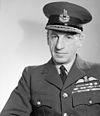 |
Marshal of the Royal Air Force |
Knight of the Garter |
Chairman of British Aircraft Corporation.[3] |
|
|
| Strong advocate of area bombing. Took over as head of the RAF after the Battle of Britain. Continually launched air raids against Germany, especially targeting civilian populations.[1] |
| Arthur Harris |
 |
Air Chief Marshal |
Knight Grand Cross of the Order of the Bath |
Manager of the South African Marine Corporation |
|
|
| Assisted Charles Portal in the strategic bombing campaign against Germany. |
| Hugh Dowding |
 |
Air Chief Marshal |
Knight Grand Cross of the Order of the Bath |
Dismissed as head of fighter command in November 1940. Became a theosophist after the war. Died in February 1970, aged 87 and buried in Westminster Abbey. |
|
|
| Leader in World War I of an RFC Squadron. Commander of the Battle of Britain. Deservedly credited with saving Britain from defeat. |
| Navy |
Andrew Cunningham |
 |
Admiral of the Fleet |
Knight of the Thistle |
Served as Lord High Commissioner to the General Assembly of the Church of Scotland. Died in June 1963, buried at sea off Portsmouth. |
|
|
| First Sea Lord 1943-1946.[1] |
| Louis Mountbatten |
 |
Admiral of the Fleet |
Knight of the Garter |
Viceroy of India until 1947. First Sea Lord from 1954 to 1957. |
|
|
| Supreme Allied Commander of SEAC. Under him were such famous generals as William Slim and Joseph Stilwell.[1] |
| Sir Alfred Pound |
 |
Admiral of the Fleet |
Knight Grand Cross of the Order of the Bath |
Died of illness, October 1943. |
|
|
| First Sea Lord 1939-1943.[1] |
| Armed Force |
Name |
Highest Rank |
Highest Award |
Fate |
Casualties inflicted |
Theatres / Battles |
| Army |
George Marshall |
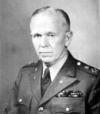 |
General of the Army |
Distinguished Service Medal, Silver Star |
As Secretary of State his name was given to the Marshall Plan, for which he was awarded the Nobel Peace Prize in 1953. |
|
|
| Was the aide to General Pershing during World War I. Was Chief of Staff having overall command of the US Army during and before World War II. Marshall served as the U.S. Army Chief of Staff during the war and as the chief military adviser to President Franklin D. Roosevelt. Many of the American generals that were given top commands during the war were either picked or recommended by Marshall, including Dwight Eisenhower, Lloyd Fredendall, Leslie McNair, Mark W. Clark and Omar Bradley.[4] He led the rapid growth of US forces, co-ordinated the Western Allies and promoted postwar reconstruction of Europe.[1] |
| Dwight D. Eisenhower |
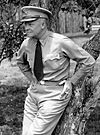 |
General of the Army |
Distinguished Service Cross, Medal of Honor (offered, but not accepted by him). |
After liberating Europe, served as NATO head and president of Columbia University before being elected the 34th President of the United States. |
|
|
| Entered the war as an assistant to the more senior Officers MacArthur and George Patton, showed his worth as a commander during the North Africa Campaign. In December 1943, President Roosevelt decided that Eisenhower—not Marshall—would be Supreme Allied Commander in Europe. The following month, he resumed command of European Theater of Operations United States Army (ETOUSA) and the following month was officially designated as the Supreme Allied Commander of the Supreme Headquarters Allied Powers Europe (SHAPE), serving in a dual role until the end of hostilities in Europe in May 1945. He was charged in these positions with planning and carrying out the Allied assault on the coast of Normandy in June 1944 under the code name Operation Overlord, to head the liberation of Europe on the Western Front and the invasion of Germany. |
| Douglas MacArthur |
 |
General of the Army |
Medal of Honor, Philippine Medal of Valor |
Tasked with rebuilding Japan after the war. Later involved in the Korean War. |
|
|
| Recalled from retirement prior to the start of the Pacific war. Early on in World War II, received the Medal of Honor for extreme bravery. Was disappointed to relinquish the Philippines to the Japanese. Promising to return, he did so in 1945 and whilst in Manila, prepared for war in Japan itself. MacArthur presided over the Japanese Unconditional Surrender in 1945. His strategy of maneuver, air strikes and force avoidance meant that soldiers under his command faced relatively low casualties.
[1]
|
| Omar Bradley |
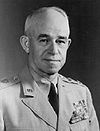 |
General of the Army |
Distinguished Service Medal (Army and Navy). |
Became Chairman of the Joint Chiefs of Staff |
|
|
| This former infantry school instructor entered the war under Patton, later becoming his boss. Towards the end of the war, led a force of over 1.3 million troops (America's largest to serve under one man).[1] |
| Mark W. Clark |
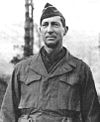 |
General |
Distinguished Service Medal (Army and Navy). |
Became head of the Citadel |
|
|
| Led the triumphal entry into Rome. Served under General Harold Alexander. Ordered the destruction of the religious abbey at Monte Cassino. Was commander-in-chief in Italy from late 1944.[1] |
| George S. Patton, Jr. |
 |
General |
Distinguished Service Cross |
Died in a road accident 4 months after the end of the war. |
|
|
| An aggressive general whose ferocious military thrusts earned him admiration and respect from all participants in the war (and at times endangered his military career). Successfully used the German tactic of armored blitzkrieg against the Germans.[1] |
| Navy |
Ernest King |
 |
Fleet Admiral |
Navy Cross |
Retired on December 15, 1945. |
|
|
| [1] United States Chief of Naval Operations. |
| Chester W. Nimitz |
 |
Fleet Admiral |
Legion of Honour, Distinguished Service Medal |
Served as Chief of Naval Operations. |
|
|
| After the attack on Pearl Harbor, took command of the Pacific Ocean areas, and turned around USA's fortunes in the Battle of Midway. Closed the war with operations in the Leyte Gulf and Okinawa.[1] |
| William Halsey, Jr. |
 |
Fleet Admiral |
Navy Cross |
Retired 1947. |
|
|
| Commander of South Pacific Area 1942-1944. Commander of United States Third Fleet 1944-1945.[1][5] |
| Frank Jack Fletcher |
 |
Admiral |
Medal of Honor |
Chairman of the General Board, retired in 1947. |
|
|
|
Recipient of the Medal of Honor for saving hundreds of refugees during the United States occupation of Veracruz in April 1914 during the Mexican Revolution. Operational commander at the pivotal Battles of Coral Sea and of Midway; nephew of Admiral Frank Friday Fletcher. In November 1942, he became Commander, Thirteenth Naval District and Commander, Northwestern Sea Frontier. A year later, he was placed in charge of the Northern Pacific area [according to Oxford companion to second world war, this occurred in October 1942].[1]
|
| Raymond A. Spruance |
 |
Admiral |
Navy Cross |
Served as President of the Naval War College. |
|
|
| Commander of two of the most significant battles of the war, Battle of Midway and the Battle of the Philippine Sea. |
| USAAF |
Henry Arnold |
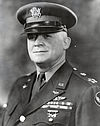 |
General of the Air Force |
Distinguished Service Medal |
|
|
|
| Member of the US Joint Chiefs of Staff, and the Combined Chiefs of Staff committees.[1] |
| Ira C. Eaker |
 |
General |
Distinguished Service Medal (Army, Navy and Air Force) |
Became deputy commander of the Army Air Forces until retirement in 1947. |
|
|
| Commander of the 8th US Bomber command.[1] |
| Carl Spaatz |
 |
General |
Air Force Cross |
Replaced Arnold in September 1947 to become chief of the US Air Force. |
|
|
| One of the pioneers of US military aviation, Spaatz advocated the use of scientific analysis to bombing raids, and made effective use of long range fighters, tactics which helped the Allies achieve air superiority over Europe.[1] |
| Armed Force |
Name |
Highest Rank |
Highest Award |
Fate |
Casualties inflicted |
Theatres / Battles |
| Army |
Georgy Zhukov |
 |
Marshal of the Soviet Union |
Twice an Order of Victory, four times Hero of the Soviet Union |
Became Soviet member of the Allied Control Council for Germany, Minister of Defense of the Soviet Union 1955-57 |
|
|
| Involved in nearly every major battle on the Eastern Front. He successfully led the defense of Moscow and later relieved Leningrad. After vying with Rokossovsky for overall command, he led all Soviet armies in the closing stages of the war and at the Battle for Berlin.[1] |
| Aleksandr Vasilevsky |
 |
Marshal of the Soviet Union |
Twice an Order of Victory, twice Hero of the Soviet Union. |
Soviet Defence Minister |
|
|
| Stalin's strategic specialist who planned and carried through many successful Soviet operations as overall commander, particularly the encirclement at Stalingrad and the grand plan for Bagration. Commander-in-Chief of Soviet Forces in the Far East during Manchurian Strategic Offensive Operation.[1] |
| Konstantin Rokossovsky |
 |
Marshal of the Soviet Union, Marshal of Poland |
Order of Victory, twice Hero of the Soviet Union. |
Polish Defense Minister |
|
|
| Decisive role in the Battle for Moscow, led encirclement forces at Stalingrad, broke German counter-attack at Kursk, advanced into Poland and eventually linked up with the Americans at Wismar.[1] |
| Boris Shaposhnikov |
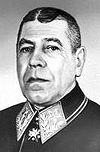 |
Marshal of the Soviet Union |
Three Orders of Lenin |
Commandant of the Voroshilov Military Academy. Died in 1945. |
|
|
| Chief of the General Staff 1937-1940, 1941-1942. Organized pre-war buildup of the Red Army. |
| Ivan Bagramyan |
 |
Marshal of the Soviet Union |
Twice Hero of the Soviet Union. |
Soviet Army commander |
|
|
| Bagramyan's experience in military planning as a chief of staff allowed him to distinguish himself as a capable commander in the early stages of the Soviet counter-offensives against Nazi Germany. |
| Nikolai Vatutin |
 |
General of the Army |
Hero of the Soviet Union |
Killed by the Ukrainian Insurgent Army. |
|
|
| Deputy of the Chief of the General Staff of the Red Army. Decisive Soviet commander at Kursk, outmanoeuvered German commander Manstein and later routed German forces in Korsun salient.[1][additional citation needed] |
| Ivan Konev |
 |
Marshal of the Soviet Union |
Order of Victory, Hero of the Soviet Union |
Appointed head of the Soviet forces in East Germany.Served as chief of the Soviet Armed Forces and Warsaw Pact. |
|
|
| Play a pivotal role in the War, retaking much of Eastern Europe. Helped in the capture of Berlin, the capital of Nazi Germany. Konev was also a competitor of leading star, Marshal Georgy Zhukov.[1] |
| Semyon Timoshenko |
 |
Marshal of the Soviet Union |
Order of Victory, twice a Hero of the Soviet Union. |
Soviet Army commander in Belarus |
|
|
| Defence Commissar till 19 July 1941. Chairman of the Stavka (Soviet High Command). A capable commander in the early stages of World War II. Played a decisive role in the Winter War and the invasion of Poland.After the disaster at Kharkov, Timoshenko was removed by Stalin from front-line command but given overall commanders in different fronts of the USSR. |
| Soviet Navy |
Ivan Isakov |
 |
Admiral of the Fleet of the Soviet Union |
Hero of the Soviet Union |
Commander-in-Chief of the Naval Forces. |
|
|
|
| Nikolay Kuznetsov |
 |
Admiral of the Fleet of the Soviet Union |
Hero of the Soviet Union |
People's Commissar of the Navy during The Second World War |
|
|
|
| Soviet Aviation |
Sergei Khudyakov |
 |
Marshal of Aviation of the Soviet Union |
|
Chief of Staff of the Air Forces of the Soviet Union, deputy commander of the Red Air Force |
|
|
|
| Alexander Novikov |
 |
Chief Marshal of Aviation of the Soviet Union |
Two times Hero of the Soviet Union |
Commander-in-Chief of the Air Forces of the Soviet Union
Chief of the High school of civil aviation |
|
|
|
| Armed Force |
Name |
Highest Rank |
Highest Award |
Fate |
Casualties inflicted |
Theatres / Battles |
| Army |
Wilhelm Keitel |
 |
Field Marshal |
Knight's Cross of the Iron Cross |
Executed in 1946. |
|
|
| Chief of the OKW during World War II.Was convicted of war crimes in the Nurembeg Trials and executed by the Allies.[1] |
| Alfred Jodl |
 |
Colonel General |
Knight's Cross of the Iron Cross |
Executed in 1946. |
|
|
| Chief of the Operations Staff of the OKW.[1] |
| Heinrich Himmler |
 |
Reichsführer-SS |
Blood Order, Golden Nazi Party |
Chief of the SS during World War II.[1] Suicide, 1945. |
|
|
| Military commander and a leading member of the Nazi Party (NSDAP) of Nazi Germany. Nazi leader Adolf Hitler later appointed him Commander of the Replacement (Home) Army and General Plenipotentiary for the administration of the entire Third Reich. Himmler was one of the most powerful men in Nazi Germany and one of the persons most directly responsible for the Holocaust. |
| Walther von Brauchitsch |
 |
Field Marshal |
Knight's Cross of the Iron Cross |
Died in 1948. |
|
|
| Commander-in-Chief of the German Army 1938-1941. |
| Paul Ludwig Ewald von Kleist |
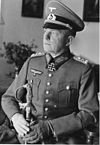 |
Field Marshal |
Knight's Cross with Oak Leaves and Swords |
Died in 1954 in a Soviet prison. Most senior German officer to die in a Soviet prison. |
|
|
| An aristocrat and senior commander in World War I. Commander of tank armies in the German Army in World War II. Fought in most of the actions involving blitzkrieg techniques. |
| Wilhelm Ritter von Leeb |
 |
Field Marshal |
Knight's Cross of the Iron Cross |
Died in 1948. |
|
|
| Exemplary service in World War I. Given the command of Army Group North in Operation Barbarossa. Was in charge of the unsuccessful siege of Leningrad, which lasted nearly 1000 days. |
| Gerd von Rundstedt |
 |
Field Marshal |
Knight's Cross of the Iron Cross with Oakleaves and Swords[8] |
Died in 1953. |
|
|
| A Kriegsakademie graduate of the Prussian nobility, and a major World War I veteran, Rundstedt distinguished himself as commander of numerous fronts of World War II including the Western and Eastern fronts of Europe.[1] |
| Günther von Kluge |
 |
Field Marshal |
Knight's Cross with Oak Leaves and Swords |
Committed suicide in 1944. |
|
|
| Commander of many successful operations including the invasion of Poland, France and the Soviet Union. Involved in the failed Hitler assassination, he decided to commit suicide.[1] |
| Georg von Küchler |
 |
Field Marshal |
Knight's Cross with Oak Leaves |
Arrested in 1948 and sent to the Soviet Union by the Americans. Released in 1953. |
|
|
| Relieved von Leeb as commander of the siege of Leningard. After this failed, withdrew Army Group North, which saved them.[1] |
| Fedor von Bock |
 |
Field Marshal |
Knight's Cross of the Iron Cross |
Was killed by a British fighter pilot in 1945 and became the only one of two of Adolf Hitler's field marshal's to die from enemy fire. |
|
|
| Recipient of the Pour le Mérite from World War I, rose rapidly in rank to field marshal by the fall of France. Took command of Army Group Centre, whose Panzer groups penetrated the furthest into Russia.Was one of the Senior Wehrmacht Commander before the outbreak of war. Play a decisive role in the defeat of Poland and France. Bock was German Army Group Center commander during Operation Barbarossa, after the defeat at Moscow was relieved of command by Hitler. After Reichenau death, he was appointed to take over Army Group South. He was instructmental in defeating Marshal Timoshenko forces at Kharkov. However, Hitler was displeased with Bock and dismissed him. Played no further part in the war[1] |
| Erich von Manstein |
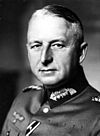 |
Field Marshal |
Knight's Cross of the Iron Cross with Oakleaves and Swords[8] |
Imprisoned after war, later released and served as senior advisor to the Bundeswehr. |
|
|
| The master of mobile battle, authored the original Sichelschnitt plan, a plan which enabled Germany to capture France with minimal casualties. Manstein was one of the ablest general Hitler had. Manstein captured Sevastapol and was responsible for shoring up the Southern Front after the defeat at Stalingrad. He later recaptured Kharkov and gave the Soviets a beating. After the defeat at Kursk, he skillfully handled his army group retreat. However, he was dismissed by Hitler after frequently clashing with him in 1944. He then played no further part in the war from then on.[1] |
| Erwin Rommel |
 |
Field Marshal |
Pour le Mérite, Knight's Cross of the Iron Cross with Oakleaves, Swords and Diamonds |
Committed suicide after being implicated in the Valkyrie plot. Official cause of death by the State was succumbing to wounds from an Allied air attack. |
|
|
| A legend in his own time, The Desert Fox headed the German campaign of North Africa. Rommel was highly decorated in World War I with the Pour le Mérite, Germany's highest award. During World War II, he made an immediate impact in the Saharan desert, conquering all of West Africa and threatening to reach Suez. A number of factors such as stretching supply lines and the reinforcement of Allied military power (both in Morocco and Egypt) turned the tide in the favour of the Allies, and his forces were routed in the Battle of Tunisia in 1943. Before he could counterattack, German high command reassigned him to defend the Atlantic Wall. Rommel failed to stop the allied invasion of Normandy. Though typically linked to the assassination of Hitler, Rommel probably did not take part in the July 20 plot as he did not want future generations to think that the Axis lost the war due to backstabbing. Nevertheless, Rommel had to commit suicide, lest he face a mock-trial which would have surely ended in the death of him, his family and his aides.[1] |
| Walter Model |
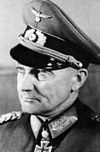 |
Field Marshal |
Knight's Cross of the Iron Cross with Oakleaves, Swords and Diamonds[8] |
Committed suicide in 1945. |
|
|
| German Army officer whose expertise in defensive warfare earned him the nickname of the 'Führer's fireman'[1] |
| Heinz Guderian |
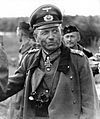 |
Colonel General |
Knight's Cross of the Iron Cross with Oak Leaves[8] |
Died in 1954. |
|
|
| Main creator of Blitzkrieg tactics. Chief of OKH General Staff 1944-1945.[1] |
| Friedrich Paulus |
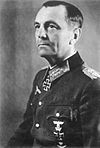 |
Field Marshal |
Knight's Cross of the Iron Cross with Oak Leaves[8] |
Soviet captivity until 1953. Became a vocal critic of the Nazi regime. |
|
|
| Commander of the disastrous campaign in the Battle of Stalingrad. |
| Josef Dietrich |
 |
SS-Oberst-Gruppenführer |
Knight's Cross of the Iron Cross with Oakleaves, Swords and Diamonds[8] |
Sentenced to life, reduced to 25 years imprisonment in 1946. Promoted welfare of ex-servicemen on release. |
|
|
| Before World War II, Dietrich was very close to Hitler, and played a part in the Night of the Long Knives. Later in World War II he became the commander of 1st SS Panzer Division Leibstandarte SS Adolf Hitler, General of the Waffen-SS and member of the Prussian state council. Dietrich came into prominence for his role in the Battle of the Bulge in late 1944. He later commanded the defense of Vienna. He was a widely respected person in Germany both during and after the war.[1] |
| Air force |
Hermann Göring |
 |
Reichsmarschall |
Grand Cross of the Iron Cross[8] |
Committed suicide after being sentenced to death for war crimes. |
|
|
| Was a high scoring air ace and took over the Red Baron's famous squadron, and won the prestigious Pour le Mérite in World War I. Hitler's second in charge. Commander-in-Chief of Luftwaffe 1935-1945. During World War II, he did not live up to his prior high standards. He was involved with the running of Germany and the war, and the central decision making, including implementation of the Holocaust.[1] |
| Albert Kesselring |
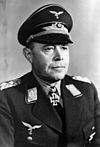 |
Field Marshal |
Knight's Cross of the Iron Cross with Oakleaves, Swords and Diamonds[8] |
Died in 1960 at the age of 75. |
|
|
| Was commander-in-chief of Luftwaffe South (1941–1943), then South-west (1943–1945), then West Europe (1945). Was a very competent commander as chief of the defense of Italy against the allies, when he caused plenty of problems, even though heavily outnumbered, including at the prolonged battles of Anzio and Monte Cassino. Was a leader in the defense of Germany at the end of the war. Kesselring was widely admired and acknowledged on both sides as a "fair fighter" and was responsible for protecting priceless artworks and even the City of Rome from destruction.[1] |
| Wolfram Freiherr von Richthofen |
 |
Field Marshal |
Knight's Cross of the Iron Cross with Oak Leaves[8] |
Died in 1945. |
|
|
|
| Robert Ritter von Greim |
 |
Field Marshal |
Knight's Cross of the Iron Cross with Oakleaves, Swords and Diamonds[8] |
Committed suicide in 1945. |
|
|
| An ace of World War I and winner of the prestigious Pour Le Merite award. Before World War II, went to China to help build their air force. A commander of the Luftwaffe during the Battle of Poland. He was loyal to Hitler to the end, flying in on 26 April 1945 with Hanna Reitsch. He and Hanna Reitsch said "It was the blackest day when we could not die at our Führer's side.".[1] |
| Kurt Student |
 |
General |
Knight's Cross of the Iron Cross with Oakleaves[8] |
Held as a Prisoner of War by the British and freed in 1948. |
|
|
| An ace of World War I. Before World War II, trained troops in airborne operations. Commanded the successful airborne operations in the Battle of Crete. Commanded the highly successful operation to free Benito Mussolini. Successful again in the defense against airborne landings near Arnhem.[1] |
| Navy |
Erich Raeder |
 |
Grand Admiral |
Knight's Cross of the Iron Cross |
Died in 1960. |
|
|
| Commander-in-Chief of Kriegsmarine 1936-1943.[1] |
| Karl Dönitz |
 |
Grand Admiral |
Knight's Cross of the Iron Cross with Oak Leaves[8] |
Briefly became President of Germany. Spent 10 years in prison. Died in 1980. |
|
|
| Commander-in-Chief of Kriegsmarine 1943-1945.[1] |
| Armed Force |
Name |
Highest Rank |
Highest Award |
Fate |
Casualties inflicted |
Theatres / Battles |
| Army |
Hideki Tojo |
 |
General |
Order of the Rising Sun |
Executed in 1948. |
|
|
| Prime minister of Japan 1941-1944 was also a military commander. Chief of the Army General Staff in 1944.[1] |
| Hajime Sugiyama |
 |
Field Marshal |
Order of the Rising Sun |
Committed suicide shortly after the end of the war. |
|
|
| Chief of the Army General Staff 1940-1944.[1] |
| Prince Kotohito Kan'in |
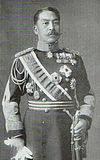 |
Field Marshal |
Order of the Chrysanthemum |
Died in 1945 |
|
|
| Chief of staff of the Army, 1931–1940 |
| Hisaichi Terauchi |
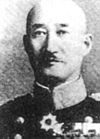 |
Field Marshal |
Order of the Rising Sun |
Died in a prisoner of war camp in Malaya June 1946. |
|
|
| Son of former PM Terauchi Masatake, became the senior officer of the Imperial Japanese after the coup of 1936. Was at one time considered as Tojo successor after the latter's resignation. |
| Shunroku Hata |
 |
Field Marshal |
Order of the Rising Sun |
Sentenced to imprisonment. |
|
|
| |
| Tomoyuki Yamashita |
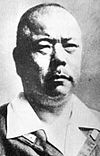 |
General |
Order of the Rising Sun |
Executed at 1946. |
|
|
| Forced the surrender of the allies in the Battle of Singapore. Defender of the Philippines against MacArthur. an American military tribunal in Manila tried General Yamashita for war crimes relating to the Manila Massacre and many atrocities in the Philippines and Singapore against civilians and prisoners of war, such as the Sook Ching massacre, and sentenced him to death. This controversial case has become a precedent regarding the command responsibility for war crimes and is known as the Yamashita Standard.[1] |
| Iwane Matsui |
 |
General |
Order of the Rising Sun |
Retired 1938, executed in 1948. |
|
|
| Arrested by the American occupation authorities after the surrender of Japan, Matsui was charged with war crimes in connection with the actions of the Japanese army in China also known as The Nanking Massacre. In 1948, the International Military Tribunal for the Far East (IMTFE) found him guilty of class B and C war crimes, and he was hanged that December at Sugamo Prison, alongside six others, including Hideki Tojo. He was 70 at the time of his death. |
| Navy |
Osami Nagano |
 |
Fleet Admiral |
Order of the Rising Sun |
Died of a heart attack in 1947. |
|
|
| Chief of the Navy General Staff, 1941-1944. |
| Prince Fushimi Hiroyasu |
 |
Fleet Admiral |
Order of the Chrysanthemum |
Died in 1946. |
|
|
| Chief of staff of the Navy, 1932-1941. |
| Isoroku Yamamoto |
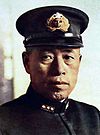 |
Fleet Admiral |
Order of the Chrysanthemum |
The plane carrying him was shot down in 1943. |
|
|
| Commander of the Dec. 7, 1941 Attack on Pearl Harbor, Hawaii. Commander-in-Chief of the Imperial Japanese Navy 1939-1943. Isoroku Yamamoto, was killed on Bougainville Island when his transport bomber aircraft was shot down by United States Army Air Forces fighter aircraft operating from Kukum Field on Guadalcanal.[1] |
| Mineichi Koga |
 |
Fleet Admiral |
Order of the Rising Sun |
Killed in plane crash 1944. |
|
|
| Commander-in-Chief of the Imperial Japanese Navy 1943-1944.[1] |
| Soemu Toyoda |
 |
Admiral |
Order of the Rising Sun |
Died in 1957 at the age of 73. |
|
|
| Commander-in-Chief of the Imperial Japanese Navy 1944-1945, Chief of staff of the Navy 1945.[1] |
| Chūichi Nagumo |
 |
Admiral |
Order of the Rising Sun |
Committed suicide in 1944 during the battle of Saipan. |
|
|
| Torpedo specialist and commander of the Carrier Striking Task Force that attacked Pearl Harbor. Successful raids at Darwin and the Indian Ocean were reversed at the Battle of Midway. Although he had tactical victories in the Guadalcanal campaigns, his battle strength was severely depleted, and was switched to the defence of the Mariana Islands.[1] |
| Jisaburō Ozawa |
 |
Vice Admiral |
Order of the Sacred Treasure |
Died in 1966. |
|
|
| Replaced Toyoda in 1945 to become commander-in-chief of the Japanese Combined Fleet[1] |



















































































































































